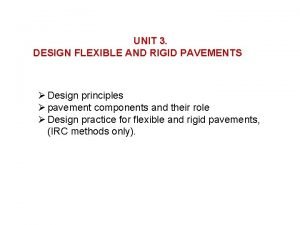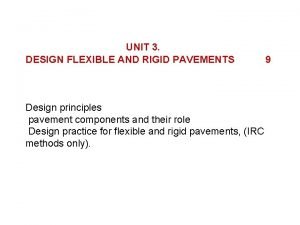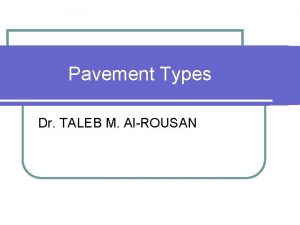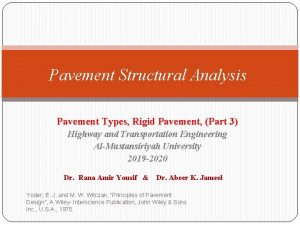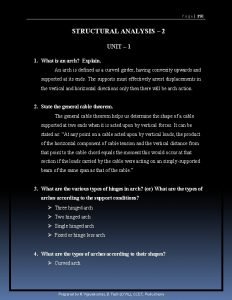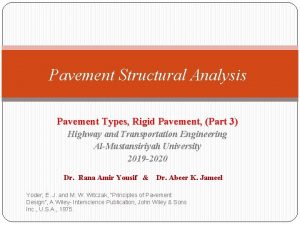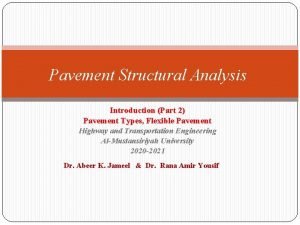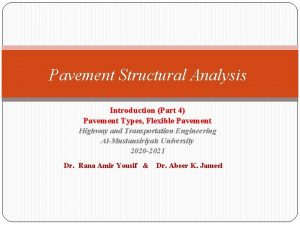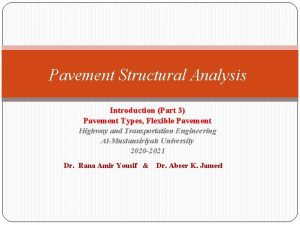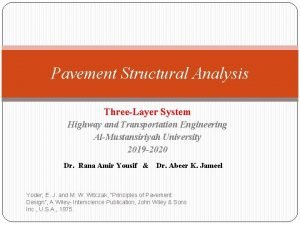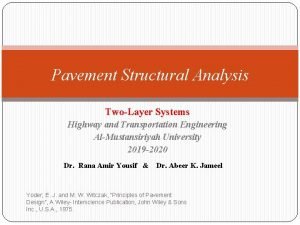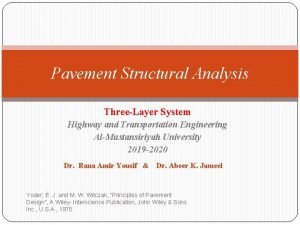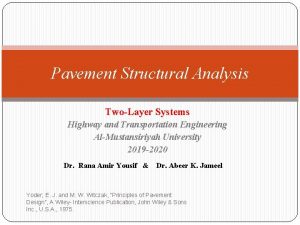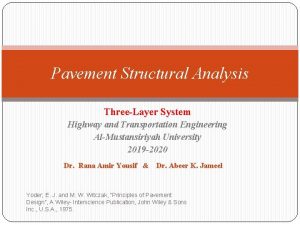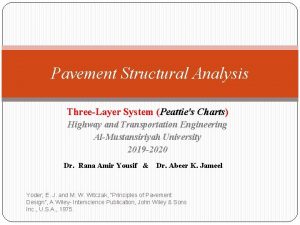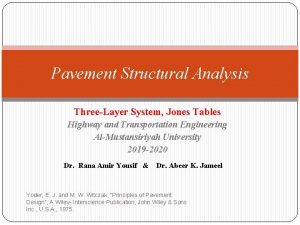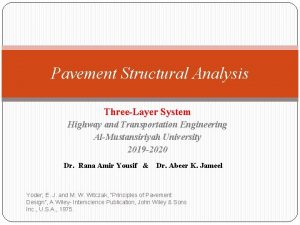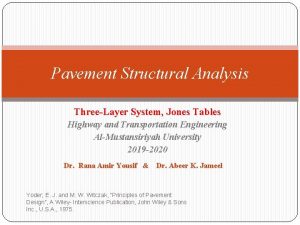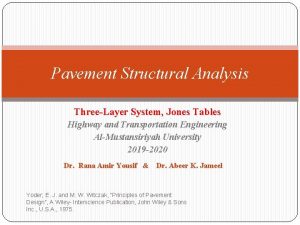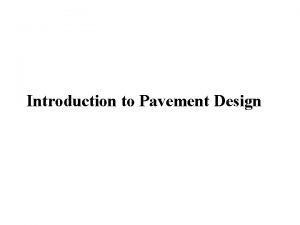Pavement Structural Analysis Pavement Types Lecture 2 Highway





































- Slides: 37

Pavement Structural Analysis Pavement Types, Lecture 2 Highway and Transportation Engineering Al-Mustansiriyah University 2020 -2021 Dr. Rana Amir Yousif & Dr. Abeer K. Jameel

Pavement Types There are three major types of pavements: 1. flexible or asphalt pavements, 2. Rigid or concrete pavements 3. composite pavements.

Rigid Pavement �A rigid pavement is constructed from cement concrete or reinforced concrete slabs. �Rigid pavements are placed either directly on the prepared subgrade or on a single layer of granular or stabilized material. �Because there is only one layer of material under the concrete and above the subgrade, some call it a base course, others a subbase.

Rigid Pavement Figure 1. 10 shows a typical cross section for rigid pavements


Rigid Pavement Transverse joints Longitudinal joints

Rigid Pavement

Rigid Pavement Use of Base Course � Early concrete pavements were constructed directly on the subgrade without a base course. � As the weight and volume of traffic increased, pumping began to occur, and the use of a granular base course became quite popular. � When pavements are subjected to a large number of very heavy wheel loads with free water on top of the base course, even granular materials can be eroded by the pulsative action of water. � For heavily traveled pavements, the use of a cement-treated or

Rigid Pavement Use of Base Course � it is uneconomical to build a base course for the purpose of reducing the concrete stress. � Because the strength of concrete is much greater than that of the base course, the same critical stress in the concrete slab can be obtained without a base course by slightly increasing the concrete thickness.

Rigid Pavement Use of Base Course The following reasons have been frequently cited for using a base course. 1. Control of Pumping 2. Control of Frost Action 3. Improvement of Drainage 4. Control of Shrinkage and Swell 5. Expedition of Construction

Rigid Pavement Use of Base Course 1. Control of Pumping � Pumping is defined as the ejection of water and subgrade soil through joints and cracks and along the edges of pavements, caused by downward slab movements due to heavy axle loads. � The sequence of events leading to pumping includes - the creation of void space under the pavement caused by the - temperature curling of the slab and the plastic deformation of the subgrade, the entrance of water, the ejection of muddy water, the enlargement of void space, and finally the faulting and cracking of the leading slab ahead

Rigid Pavement - Pumping occurs under the leading slab when the trailing slab rebounds, which creates a vacuum and sucks the fine material from underneath the leading slab, as shown in Figure 1. 11. The corrective measures for pumping include joint sealing, under sealing with asphalt cements, and muck jacking with soil cement.

Rigid Pavement Pumping

Rigid Pavement Three factors must exist simultaneously to produce pumping: a. The material under the concrete slab must be saturated with free water. If the material is well drained, no pumping will occur. Therefore, good drainage is one of the most efficient ways to prevent pumping. b. There must be frequent passage of heavy wheel loads. Pumping will take place only under heavy wheel loads with large slab deflections. Even under very heavy loads, pumping will occur only after a large number of load repetitions. c. The material under the concrete slab must be erodible. The credibility of a material depends on the hydrodynamic forces created by the dynamic action of moving wheel loads. Any untreated granular materials, and even some weakly cemented materials, are erodible because the large hydrodynamic pressure will transport the fine particles in the subbase or subgrade to the surface. These fine particles will go into suspension and cause

Rigid Pavement 2. Control of Frost Action: � Frost action is detrimental to pavement performance. � It results in frost heave, which causes concrete slabs to break and softens the subgrade during the frost-melt period.

Rigid Pavement 2. Control of Frost Action: � In northern climates, frost heave can reach several inches or more than one foot. � The increase in volume of 9% when water becomes frozen is not the real cause of frost heave. � For example, if a soil has a porosity of 0. 5 and is subjected to a frost penetration of 3 ft (0. 91 m), the amount of heave due to 9% increase in volume is 0. 09 x 3 x 0. 5 = 0. 135 ft or 1. 62 in. (41 mm), which is much smaller than the 6 in. (152 mm) or more of heave experienced in such climate.

Rigid Pavement

Rigid Pavement Failure of flexible pavements Figure 1. 12: Formation of ice lenses, due to frost action.

Rigid Pavement Three factors must be present simultaneously to produce frost action: � The soil within the depth of frost penetration must be frost susceptible. - It should be recognized that silt is more frost susceptible than clay because it has both high capillarity and high permeability. - Although clay has a very high capillarity, its permeability is so low that very little water can be attracted from the water table to form ice lenses during the freezing period. - Soils with more than 3% finer than 0. 02 mm are generally frost susceptible, except that uniform fine sands with more than 10% finer than 0. 02 mm are frost susceptible.

Rigid Pavement Three factors must be present simultaneously to produce frost action: � There must be a supply of water. Lowering the water table by subsurface drainage is an effective method to minimize frost action. � The temperature must remain freezing for a sufficient period of time. Due to the very low permeability of frostsusceptible soils, it takes time for the capillary water to flow from the water table to the location where the ice lenses are formed. A quick freeze does not have sufficient time to form ice lenses of any significant size.

Rigid Pavement 3. Improvement of Drainage: � When the water table is high and close to the ground surface, a base course can raise the pavement to a desirable elevation above the water table. � When water seeps through pavement cracks and joints, an open-graded base course can carry it away to the road side. � Cedergren (1988) recommends the use of an open-graded base course under every important pavement to provide an internal drainage system capable of rapidly removing all water that enters.

Rigid Pavement 4. Control of Shrinkage and Swell: � When moisture changes cause the subgrade to shrink and swell, the base course can serve as a surcharge load to reduce the amount of shrinkage and swell. � A dense-graded or stabilized base course can serve as a water proofing layer, and an open-graded base course can serve as a drainage layer. � Thus, the reduction of water entering the subgrade further reduces the shrinkage and swell potentials.

Rigid Pavement 5. Expedition of Construction: � A base course can be used as a working platform for heavy construction equipment. � Under inclement weather conditions, a base course can keep the surface clean and dry and facilitate the construction work. As can be seen from the above reasoning, there is always a necessity to build a base course. Consequently, base courses have been widely used for rigid pavements.

Rigid Pavement Types of Rigid Pavements Rigid pavements can be classified into four types: 1. Jointed Plain Concrete Pavement JPCP 2. Jointed Reinforced Concrete Pavement JRCP 3. Continuous Reinforced Concrete Pavement CRCP 4. Prestressed Concrete Pavements PCP

Rigid Pavement 1. Jointed Plain Concrete Pavement: � plain cement concrete pavements constructed with closely spaced contraction joints. � Dowel bars or aggregate interlocks are normally used for load transfer across joints. � They normally have a joint spacing of 5 to 10 m. Dowel bars

Rigid Pavement 1. Jointed Plain Concrete Pavement:

Rigid Pavement 2. Jointed Reinforced Concrete Pavement: � Although reinforcements do not improve the structural capacity significantly, they can drastically increase the joint spacing to 10 to 30 m. � Dowel bars are required for load transfer. � Reinforcement's help to keep the slab together even after cracks.

Rigid Pavement 2. Jointed Reinforced Concrete Pavement:

Rigid Pavement JRCP

Rigid Pavement 3. Continuous Reinforced Concrete Pavement: Complete elimination of joints is achieved by reinforcement.

Rigid Pavement

Rigid Pavement 4. Pre-stressed Concrete Pavements: � Concrete is weak in tension but strong in compression. � The thickness of concrete pavement required is governed by its modulus of rupture, which varies with the tensile strength of the concrete. � The pre-application of a compressive stress to the concrete greatly reduces the tensile stress caused by the traffic loads and thus decreases the thickness of concrete required. � The pre-stressed concrete pavements have less probability of cracking and fewer transverse joints and therefore result in less maintenance and longer pavement life.

Rigid Pavement

Rigid Pavement Failure criteria of rigid pavements • Traditionally fatigue cracking has been considered as the major or only criterion for rigid pavement design. The allowable number of load repetitions to cause fatigue cracking depends on the stress ratio between flexural tensile stress and concrete modulus of rupture. • Pumping is identified as an important failure criterion. Pumping is the ejection of soil slurry through the joints and cracks of cement concrete pavement, caused during the downward movement of slab under the heavy wheel loads. • Other major types of distress in rigid pavements include faulting, spalling, and deterioration.

Composite pavement 1. 3 Composite Pavements: • Composite pavement is composed of both HMA and PCC. • The use of PCC as a bottom layer and HMA as a top layer results in an ideal pavement with the most desirable characteristics. • The PCC provides a strong base and the HMA provides a smooth and non- reflective surface. • However, this type of pavement is very expensive and is rarely used as a new construction.

Composite pavement

Composite pavement
 Flexible pavement vs rigid pavement
Flexible pavement vs rigid pavement Flexible pavement
Flexible pavement Compare rigid and flexible pavement
Compare rigid and flexible pavement Asphalt pavement design example
Asphalt pavement design example 01:640:244 lecture notes - lecture 15: plat, idah, farad
01:640:244 lecture notes - lecture 15: plat, idah, farad Cables and arches structure
Cables and arches structure Life is a highway meaning
Life is a highway meaning Conventional flexible pavement
Conventional flexible pavement Types of joints in concrete pavement
Types of joints in concrete pavement Contraction joint in rigid pavement
Contraction joint in rigid pavement Conventional/stylized decorative design
Conventional/stylized decorative design What is decorative design
What is decorative design Forest plant adaptations
Forest plant adaptations Exemple de lecture dirigée
Exemple de lecture dirigée Preapared
Preapared Energy method in structural analysis
Energy method in structural analysis Functionalism in sociology
Functionalism in sociology Structural functional analysis is given by
Structural functional analysis is given by Oliver msa
Oliver msa Satk mark
Satk mark Linear structural analysis
Linear structural analysis Structural analysis chapter 8 solutions
Structural analysis chapter 8 solutions Internal loadings
Internal loadings Inequality
Inequality Statically indeterminate
Statically indeterminate Maxwell's theorem in structural analysis
Maxwell's theorem in structural analysis Approximate analysis of statically indeterminate structures
Approximate analysis of statically indeterminate structures Eddy's theorem in structural analysis
Eddy's theorem in structural analysis Slope deflection method
Slope deflection method Structural analysis literature
Structural analysis literature Influence diagram structural analysis
Influence diagram structural analysis Betti theorem
Betti theorem Structural analysis
Structural analysis Structural analysis
Structural analysis Ce 6602
Ce 6602 Structural analysis
Structural analysis Functional analysis for engineers
Functional analysis for engineers What is functional analysis in engineering
What is functional analysis in engineering
